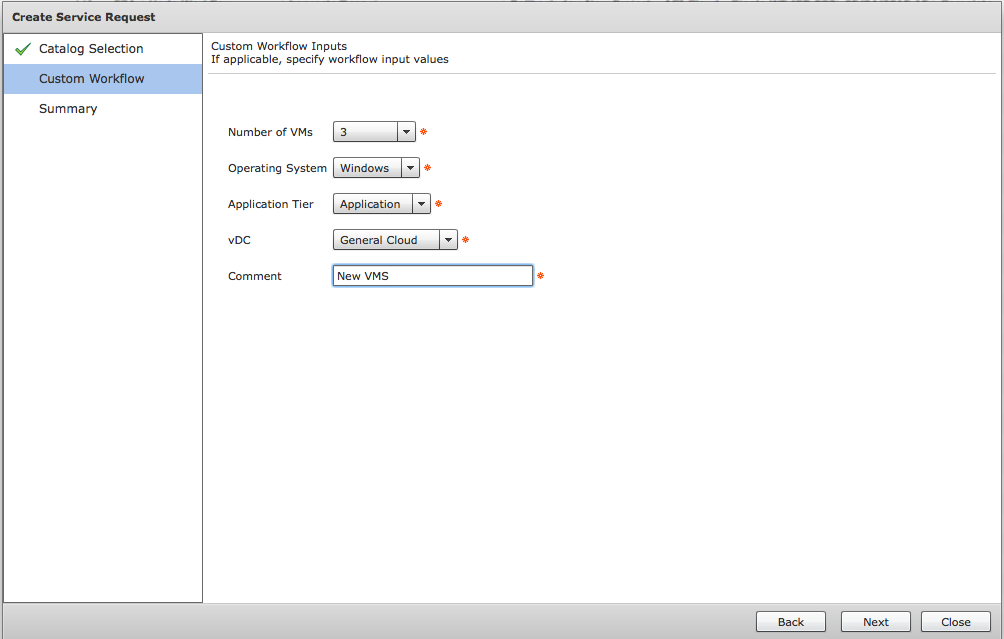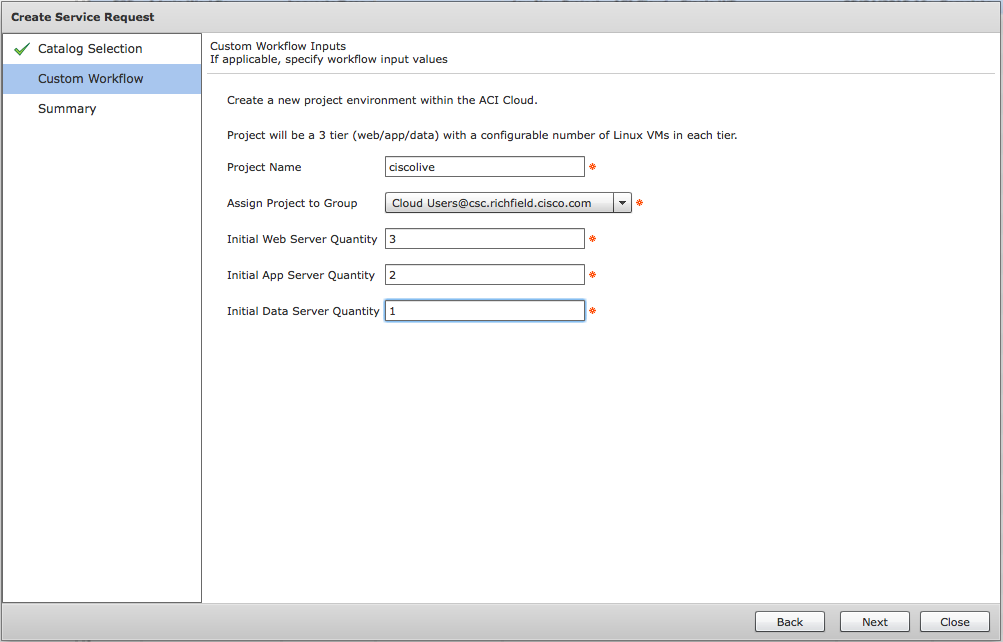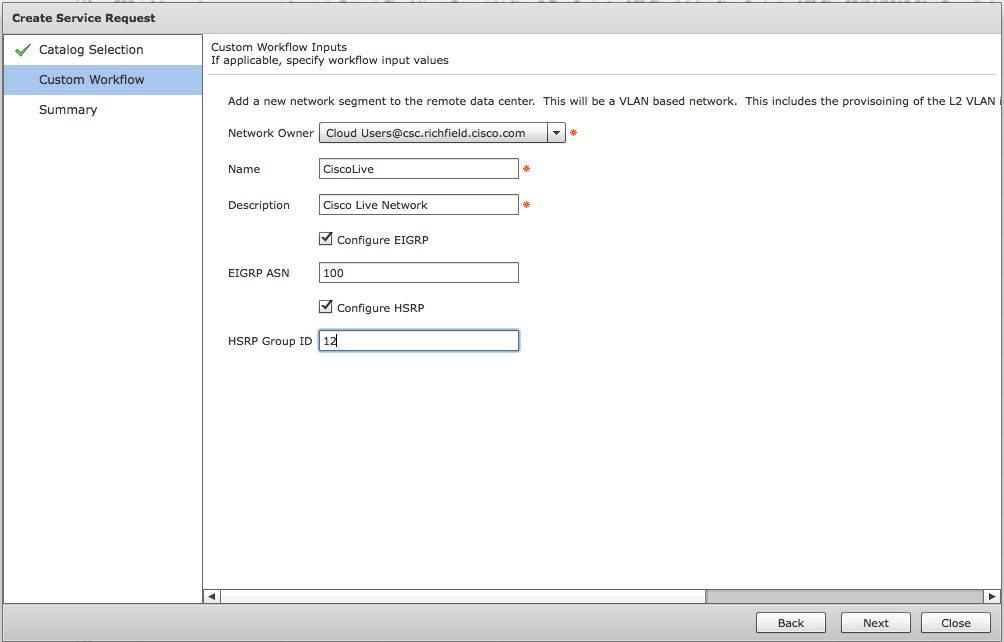- Cisco Community
- Technology and Support
- Data Center and Cloud
- UCS Director
- UCS Director Knowledge Base
- CiscoLive TECDCT-2750 UCS Director Samples
- Subscribe to RSS Feed
- Mark as New
- Mark as Read
- Bookmark
- Subscribe
- Printer Friendly Page
- Report Inappropriate Content
- Subscribe to RSS Feed
- Mark as New
- Mark as Read
- Bookmark
- Subscribe
- Printer Friendly Page
- Report Inappropriate Content
05-27-2015 08:54 PM - edited 03-01-2019 06:35 AM
| Task Name | Cisco Live Examples |
| Description |
|
| Prerequisites |
|
| Category | Workflow |
| Components | vSphere 5.x |
| User Inputs |
Instructions for Regular Workflow Use:
- Download the attached .ZIP file below to your computer. *Remember the location of the saved file on your computer.
- Unzip the file on your computer. Should end up with a .WFD file.
- Log in to UCS Director as a user that has "system-admin" privileges.
- Navigate to "Policies-->Orchestration" and click on "Import".
- Click "Browse" and navigate to the location on your computer where the .WFD file resides. Choose the .WFD file and click "Open".
- Click "Upload" and then "OK" once the file upload is completed. Then click "Next".
- Click the "Select" button next to "Import Workflows". Click the "Check All" button to check all checkboxes and then the "Select" button.
- Click "Submit".
- A new folder should appear in "Policies-->Orchestration" that contains the imported workflow. You will now need to update the included tasks with information about the specific environment.
This post and the linked workflow library is a compilation post and library covering the Private Cloud/Infrastructure Automation Use Cases discussed in TECDCT-2750: Unleash the Power of Cisco Enterprise Cloud Suite for Infrastructure Management and Automation at CiscoLive San Diego 2015. This is a 4 hour Tectorial presented by myself and Steve Wasko that aims to help enterprise IT Engineering teams begin to bring automation and programmability into their environments leveraging the capabilities Cisco provides native to some our platforms, as well as using the software tools included with Cisco ONE Enterprise Cloud Suite.
During the presentation, we cover several actual use cases that we’ve heard from customers, as well as helped prove out in proof of concepts, and how these can be tackled with the CECS stack. All the source workflows, custom tasks, etc referenced in this presentation are included in the attached library. This post will review each use case briefly for anyone unfamiliar with the CiscoLive session, as this library is valuable on it’s own right.
Use Case 1: Bulk Virtual Machine Provisioning Based on User Inputs

In this use case we expand on the basic, standard catalog offering that most customers begin with, to provide a more user friendly experience requesting new virtual machines. Rather than present the user with 10s of catalog choices for every type of VM they might want (ex Windows Web, Windows App, Windows Data, RedHat Web, …), we present the user with a single catalog where they choose key details that can be leveraged to deploy the proper virtual machine. This workflow leverages a slightly modified clone of the standard VMware VM Provision workflow that comes OOB from UCSD, a bit of processing logic, and a basic loop construct to deploy the VMs requested.
Use Case 2: Bare Metal Provisioning

None of my customers data centers are 100% virtualized, and I expect it will stay that way for awhile. This use case enables end users to request a Bare Metal Server (RedHat in my example), that will automatically be provisioned and deployed. The workflow used here leverages UCS Central Global Service Profiles, but could be updated to leverage UCS Manager directly. A LUN is provisioned on a VNX array, and an MDS SAN is configured to connect the LUN to the Service Profile. Customers using other Disk vendors, or a Brocade SAN can use this example for flow, but will need to update to their hardware platforms. The Bare Metal Agent (BMA) appliance is leveraged to deploy the OS through a standard PXE process.
Use Case 3: New Multi-Tier Application Project

A common theme I’m hearing from customers is the need to have better “segmentation” in their data centers. There are several technical ways to build this segmentation, but often what is missed is the user experience to build these segmented application environments for application development or installation of a commercial package. This use case offers an end user the ability to automatically provision a dedicated multi-tier (in this example Web, App, Data, but that could be changed to meet other needs), for an individual application. Users are also able to request a starting number of virtual machines to be deployed into the new environment to allow quick development time.

The network segmentation for this Project Environment could be provided by an underlying ACI Fabric, or via a more traditional VLAN segmentation on an NX-OS based network. For this use case, workflows are presented that address both possibilities. For customers leveraging ACI, the included workflow will create an Application Network Profile and EPGs to build the network structure. For customers with a more traditional network, the workflow will automatically deploy new VLAN for each tier. A bonus in the Traditional workflow is that it leverages a Cisco ASA to provide the security segmentation between tiers, and an F5 BigIP Appliance to Load balance the servers in the Web Tier.
Use Case 4: Expand Cloud Compute Capacity
Infrastructure Automation can also be used for more IT focused use cases. This example leverages UCS Director Workflow to automatically provision a new ESX host, and then have it join the vCenter Cluster resources being leveraged for end user virtual compute support. This workflow starts out exactly like the Bare Metal Provisioning workflow, but after deploying the ESX OS, it moves on and uses automation to register with vCenter, configure virtual storage and network, and make it available for taking workloads from other cluster members.
Use Case 5: Add a New Network Segment to the Data Center

A common request from customers is the ability to more easily, constantly, and confidently add new network segments to their data centers across physical network, virtual network, physical compute, and virtual compute environments. This use case leverages UCS Director to do just that. Similar to the Multi-Tier Application Project, this use case could be leveraging an ACI based network, or a more traditional Nexus network. A workflow is included for either potential network solution.
In addition to the base workflows for the use cases above, there are several Compound Workflows, and some Custom Tasks included that are used within the resources for tasks that were not included Out of the Box with UCS Director. These are included both to support the use cases, but also as resources for customers that find themselves confronted with a need that is not yet supported out of the box.
Some of the valuable additions include:
- Configure IP Addressing, Routing, and HSRP on a Nexus OS SVI
- Deploy Multiple Virtual Machines to a Virtual Data Center
- Create a New UCS Director VDC
- Create a New Virtual Server in an F5 Appliance (the OOB task has some bugs that required some custom work)
- UCS Central Tasks for VLAN Manipulation
I hope you find this library and resources valuable.
Find answers to your questions by entering keywords or phrases in the Search bar above. New here? Use these resources to familiarize yourself with the community:
